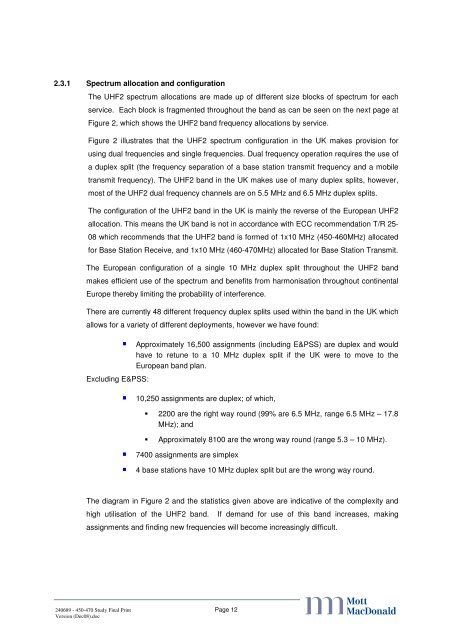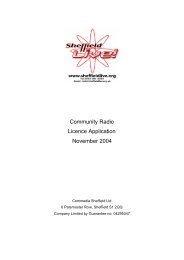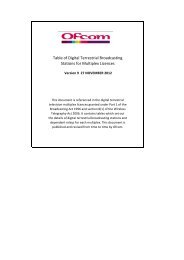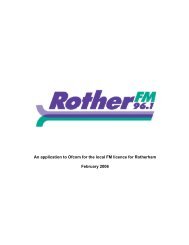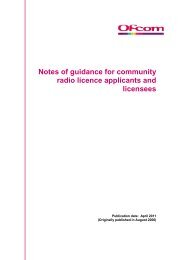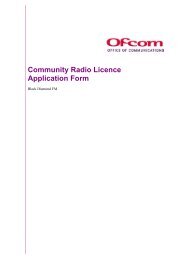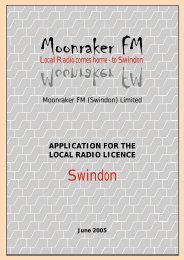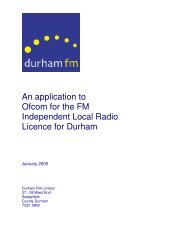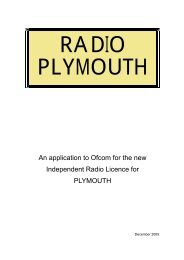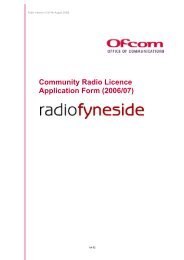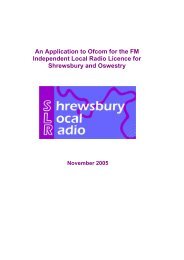UHF2 realignment study - Ofcom Licensing
UHF2 realignment study - Ofcom Licensing
UHF2 realignment study - Ofcom Licensing
You also want an ePaper? Increase the reach of your titles
YUMPU automatically turns print PDFs into web optimized ePapers that Google loves.
2.3.1 Spectrum allocation and configuration<br />
The <strong>UHF2</strong> spectrum allocations are made up of different size blocks of spectrum for each<br />
service. Each block is fragmented throughout the band as can be seen on the next page at<br />
Figure 2, which shows the <strong>UHF2</strong> band frequency allocations by service.<br />
Figure 2 illustrates that the <strong>UHF2</strong> spectrum configuration in the UK makes provision for<br />
using dual frequencies and single frequencies. Dual frequency operation requires the use of<br />
a duplex split (the frequency separation of a base station transmit frequency and a mobile<br />
transmit frequency). The <strong>UHF2</strong> band in the UK makes use of many duplex splits, however,<br />
most of the <strong>UHF2</strong> dual frequency channels are on 5.5 MHz and 6.5 MHz duplex splits.<br />
The configuration of the <strong>UHF2</strong> band in the UK is mainly the reverse of the European <strong>UHF2</strong><br />
allocation. This means the UK band is not in accordance with ECC recommendation T/R 25-<br />
08 which recommends that the <strong>UHF2</strong> band is formed of 1x10 MHz (450-460MHz) allocated<br />
for Base Station Receive, and 1x10 MHz (460-470MHz) allocated for Base Station Transmit.<br />
The European configuration of a single 10 MHz duplex split throughout the <strong>UHF2</strong> band<br />
makes efficient use of the spectrum and benefits from harmonisation throughout continental<br />
Europe thereby limiting the probability of interference.<br />
There are currently 48 different frequency duplex splits used within the band in the UK which<br />
allows for a variety of different deployments, however we have found:<br />
Excluding E&PSS:<br />
240689 - 450-470 Study Final Print<br />
Version (Dec08).doc<br />
Approximately 16,500 assignments (including E&PSS) are duplex and would<br />
have to retune to a 10 MHz duplex split if the UK were to move to the<br />
European band plan.<br />
10,250 assignments are duplex; of which,<br />
2200 are the right way round (99% are 6.5 MHz, range 6.5 MHz – 17.8<br />
MHz); and<br />
Approximately 8100 are the wrong way round (range 5.3 – 10 MHz).<br />
7400 assignments are simplex<br />
4 base stations have 10 MHz duplex split but are the wrong way round.<br />
The diagram in Figure 2 and the statistics given above are indicative of the complexity and<br />
high utilisation of the <strong>UHF2</strong> band. If demand for use of this band increases, making<br />
assignments and finding new frequencies will become increasingly difficult.<br />
Page 12<br />
abc


